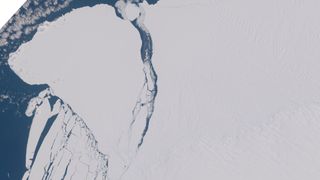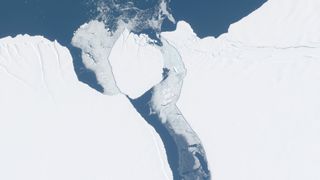Wow! Iceberg larger than London breaks off Antarctica (photos)
The moon seems to have helped the separation of the new iceberg.

A giant iceberg almost the size of London has broken off the Brunt Ice Shelf in western Antarctica on Sunday (Jan. 22) after years of cracking.
The shelf calved during the spring tide, the regular swelling of the ocean that coincides with full and new moons, according to a statement from the British Antarctic Survey (BAS), which reported the iceberg's separation from the shelf.
Since the iceberg broke off, multiple satellites have flown over the area, taking images of the now-orphaned triangular ice fragment. BAS, which operates the Halley Research Station on the Brunt Ice Shelf, estimated the size of the calved iceberg to be 600 square miles (1,550 square kilometers). That's about the size of the London metropolitan area and a little larger than Houston.
Related: Antarctica's 'Doomsday Glacier' could meet its doom within 3 years
The calving is not related to climate change, BAS said in a statement, and was caused by "natural processes" that have been underway for more than 10 years. The iceberg calved along a crack known as Chasm-1, which BAS scientists have monitored since 2012. The gradual widening of Chasm-1 in fact prompted BAS to move the Halley Research Station 14 miles (23 km) inland in 2016. The outpost has not been affected by the calving, BAS said.
"Our glaciologists and operations teams have been anticipating this event," BAS director Jane Francis said in the statement.
That said, the moon may have nudged the new iceberg on its way as the parting happened during the so-called spring tide, the "springing forth of the tide" that takes place around the new and full moons as a result of the moon's gravitational pull, according to the U.S. National Oceanic and Atmospheric Administration. In spite of the name, these phenomena have nothing to do with the season of spring!
Get the Space.com Newsletter
Breaking space news, the latest updates on rocket launches, skywatching events and more!
The Sunday calving is the second such event in the past two years affecting the Brunt Ice Shelf, BAS said in the statement. BAS monitors the area using an automated network of high-precision GPS sensors located around the station as well as data from Earth-observing satellites.

"This calving event has been expected and is part of the natural behavior of the Brunt Ice Shelf," BAS glaciologist Dominic Hodgson said in the statement. "It is not linked to climate change. Our science and operational teams continue to monitor the ice shelf in real-time to ensure it is safe, and to maintain the delivery of the science we undertake at Halley."
Since 2017, the Halley Research Station, which played a key role in the discovery and research of the ozone hole in the 1980s, has only been inhabited during the Antarctic summer, between November and March each year. The current crew of 21 researchers and staff will remain at the station until around Feb. 6, BAS said.


The 500-foot-thick (150 meters) Brunt Ice Shelf is a floating sheet of ice that moves at a rate of up to 1.2 miles (2 km) per year westward into the Weddell Sea. Thanks to the work of BAS, the shelf is one of the most extensively monitored ice shelves on Earth. Observations on-site and from satellites revealed in December that Chasm-1 had propagated through the entire ice shelf and that the calving was pending.
BAS expects that the Antarctic Coastal Current will now carry the new iceberg away in the westward direction. The iceberg will soon be given a name by the U.S. National Ice Center while glaciologists follow its movement.
Follow Tereza Pultarova on Twitter @TerezaPultarova. Follow us on Twitter @Spacedotcom and on Facebook.
Join our Space Forums to keep talking space on the latest missions, night sky and more! And if you have a news tip, correction or comment, let us know at: community@space.com.

Tereza is a London-based science and technology journalist, aspiring fiction writer and amateur gymnast. Originally from Prague, the Czech Republic, she spent the first seven years of her career working as a reporter, script-writer and presenter for various TV programmes of the Czech Public Service Television. She later took a career break to pursue further education and added a Master's in Science from the International Space University, France, to her Bachelor's in Journalism and Master's in Cultural Anthropology from Prague's Charles University. She worked as a reporter at the Engineering and Technology magazine, freelanced for a range of publications including Live Science, Space.com, Professional Engineering, Via Satellite and Space News and served as a maternity cover science editor at the European Space Agency.